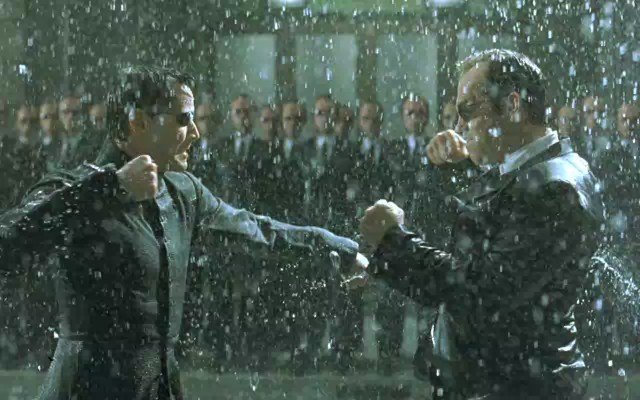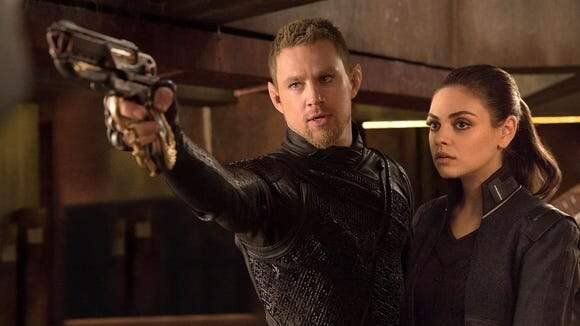In 1999, I recall sitting on a couch watching television when a movie ad appeared. “What is the Matrix?” asked a sunglass-clad actor. Keanu Reeves stood on a rooftop as the actor jumped impossibly high and landed on the next skyscraper, Keanu uttering, “Woah.” It looked vaguely sci-fi, or perhaps superhero-ish, and I was mildly interested. When it released to movie theaters, I went to see it, and…my mind was blown. Here was Bill & Ted’s Keanu opening up a serious can of whoop-ass, dodging bullets in bullet-time, with a sidekick who could run up walls, wrapped up in a mind-bending plot about escaping from reality. There are very few movies that I’ve seen in the theaters more than once, but I returned with some of my karate school friends (and we mimicked the movie’s moves for quite some time), and a few months later when I was on a business trip and the local IMAX theatre had it, I went to see it by myself in IMAX. I bought the soundtrack, and listened to it on my daily work commute.
In 2003, I recall flipping through an entertainment magazine that had an article about the upcoming sequel, the Matrix Reloaded. It featured a clip from the first big fight scene, the Chateau battle:
I wondered, after the ending of the first movie, what could possibly be a challenge for Neo? After all, he ended the movie essentially as a god able to completely reshape the Matrix to whatever he wanted. When I went to see Reloaded, there were parts of it I really liked - the freeway battle in particular - but there was something a bit numb already filtering into the series. During the Chateau battle, for example, you could almost see Keanu going through his memorized movies like a karate student executing a kata. The whole battle was spectacular and precise, but its outcome seemed inevitable, and even Neo seemed like he would have preferred to hit the fast forward button to the spot where all of the bodies were sprawled on the ground and he was the last man standing. Still, for a series that introduced bullet-time, the freeway chase managed to show us once again something we hadn’t seen before, in a way that was exciting and unpredictable.
When the Matrix Revolutions was released later in the same year, the series took its nosedive. All of the glitzy costumes and superhuman powers of the Matrix were traded for normal humans in drab tattered sacks plotting war in an underground city. When Neo and Smith finally clash in their concluding battle, they are both so omnipotent and indestructible that it’s a bore.
Let’s face it: the Matrix should have ended after the first movie. Don’t get me wrong - the second movie had plenty of Matrix fun (although not nearly as much as the first) - but the first movie was a complete story with the Matrix defeated and our hero able to remake it however he wanted (or not at all). The subsequent movies, which tried to explain where the Matrix and Neo came from, were entirely unnecessary. It would be like making a prequel to the Planet of the Apes to show exactly how the Statue of Liberty got buried. While you could spell it all out in a ninety-minute flick, people were like, “Oh yeah. We blew it all up. Got it.”
The Matrix’s reality-is-not-real concept wasn’t new. Dark City had a similar plot with a person trapped in a false reality (and Dark City is a brilliant movie to watch all on its own. Its final reveal is equally mind-bending), but the Matrix turned anime comics into amazing live action. We’ve all seen endless martial arts flicks, but somehow the martial arts in the Matrix were like nothing we’ve seen before.
1998’s Dark City - What if your entire city and everyone in it changed every night, and you were the only one who remained the same?
There were several video games and spinoffs, such as the Animatrix, between now and then, but fast-forward to December 2021 for the release of the fourth movie in the series, the Matrix Resurrections. I watched it today, streaming on HBO Max.
There was a point in the movie’s two-and-a-half-hour runtime where my brain had enough and started distracting itself with memories of better movies, and I know exactly where that point was. It’s when two of the characters ride flying manta ray/dolphin mechs, straddling them like World of Warcraft mounts, soaring semi-seriously through the red goo pods of the human harvester fields. Right about here was where I’d realized I was in Jupiter Ascending territory. In case you rightfully forgot Jupiter Ascending, it was also a Wachowski film, featuring a hover-skating Chanum Tatum elf pew-pewing it with evil aliens.
Without getting too spoilery, the plot of the Matrix Resurrections is that Neo and Trinity must get together, for…reasons. Yes, yes…they died at the end of movie three, but like Spock’s noble sacrifice in Wrath of Khan easily being undone by the studio’s desire to have more sequels (and indeed, Spock did live long and prosper after his death, thriving well into the Next Generation), Neo and Trinity are resurrected. Other dead characters, such as Agent Smith, are also resurrected, while some (without naming them to avoid spoilers) are digitally rebranded.
In some ways, the Neo/Trinity portion of the plot reminds me very loosely of 2011’s The Adjustment Bureau. In it, Matt Damon’s character needs to interact with Emily Blunt’s character, but not too much. Forces in the movie are trying to ensure the two walk the fine line between just enough and not too much. Similarly, Neo and Trinity are linked but must be kept apart.
The Adjustment Bureau, based on the Phillip K. Dick story. Phillip K. Dick also wrote A Scanner Darkly, which starred Keanu Reeves.
The best thing about Resurrections is the performance of its villains. Jonathan Groff (Mindhunters, Hamilton), is excellent as Agent Smith. I’m sure you’ve seen the trailer with him yelling, “Mister Anderson!”
Neil Patrick Harris plays Neo’s therapist, who works very hard to convince Neo that his delusions of being trapped in an alternate reality are just that - delusions. He’s at his best when the script lets him be manipulative during the first half of the movie.
Much of the movie is about getting an emotionally-scarred and somewhat-powerless Neo out of the Matrix, and then an Oceans Eleven style caper to break Trinity out. Neo’s sole remaining power is a Witcher-like Aard telekinetic blast. If you’ve played the Witcher games, that’s a minor power that you mash the A button on your controller periodically to buy you a few seconds. Neo uses it mostly the same way here. It does fit in the plot that he’s been in the Matrix for so long that he’s forgotten who he is and how to use his powers, but I was expecting a “he’s starting to believe” moment. There’s a slight escalation of his telekinetic blast to stop bullets, but everything you saw in the trailer is it.
The action sequences are…straight forward. During the fights, at first I thought that everything was slowed down and mushy because the main actors are a bit older - but this style extended to the 20-something actors as well. Unlike the government building battle of the first movie, where Neo and Trinity run between marble pillars as bullets zing and crack into rock, characters in Resurrections simply stand still in the middle of hallways as dozens of soldiers shoot automatic weapons at them, somehow missing as if they were firing blanks
The ending battle morphs into a World War Z zombie hoard and truly feels like a video game, with helicopters shooting missiles and characters dodging explosions. There’s no memorable Matrix Reloaded freeway chase or Neo with the chain gun in a helicopter freeing Morpheus. Well, actually there is the helicopter chain gun scene, complete with the same exact camera shot looking up as the shells rain down. This is certainly meant to pay homage, but so much of the movie either recycles the first movie (in some cases doing a split screen with footage of the first movie beside the current in case you somehow miss it), or does on-the-nose references, like Neil Patrick Harris’s black cat named Deja Vu, complete with a food bowl with giant white Deja Vu letters. The only thing it’s missing is a blinking arrow pointing at the cat. My other complaint about the action scenes is that they simply decide that they are done at some point. During an early battle with Agent Smith, Neo telekinetic blasts him through a wall and then switches gears to calmly chat with his team in the same location, as if Agent Smith won’t just dart back in through the hole and continue the fight. Fortunately for Neo, Smith just gave up, I presume.
So, with all of this negatively, what is it that I liked? I liked the clever self-awareness. Neo is trapped in the Matrix believing he is a computer programmer who created an insanely popular trilogy of computer games called the Matrix that featured all of the characters and plot of the Matrix movies. On his desk, he has a Trinity action figure falling backwards shooting both guns, and a Sentinel figurine. Whenever he believes anything from his previous life was real, his therapist redirects him to acknowledge this is the fantasy world he’s built for himself. Neil Patrick Harris, as his therapist and gatekeeper, is quite a brilliant touch to keep someone in the Matrix. The rebooted Agent Smith has a different personality than the original, but it works. He’s confident, cocky, and in control. The seething disdain of the original Smith is gone.
Overall, however, we didn’t need a fourth movie. I’d place the quality of the fourth movie on par with the third, which is to say…not great. It’s hard to be negative because I really like Keanu Reeves and all of the actors in the movie, but there wasn’t much point to the movie other than to give Neo and Trinity the happy ending they were denied at the end of the third movie. I get the feeling that the Wachowskis are more into the Neo/Trinity love story than the rest of us. Even in the first Matrix movie, Neo and Trinity’s relationship was incidental. When I excitedly recruited my karate school to go see the original movie, it wasn’t, “Hey guys, you have to see this romance!” So, in my mind, I think I’ll just remember Neo flying off at the end of the first movie, with the sky as the limit for what he’ll do next.












